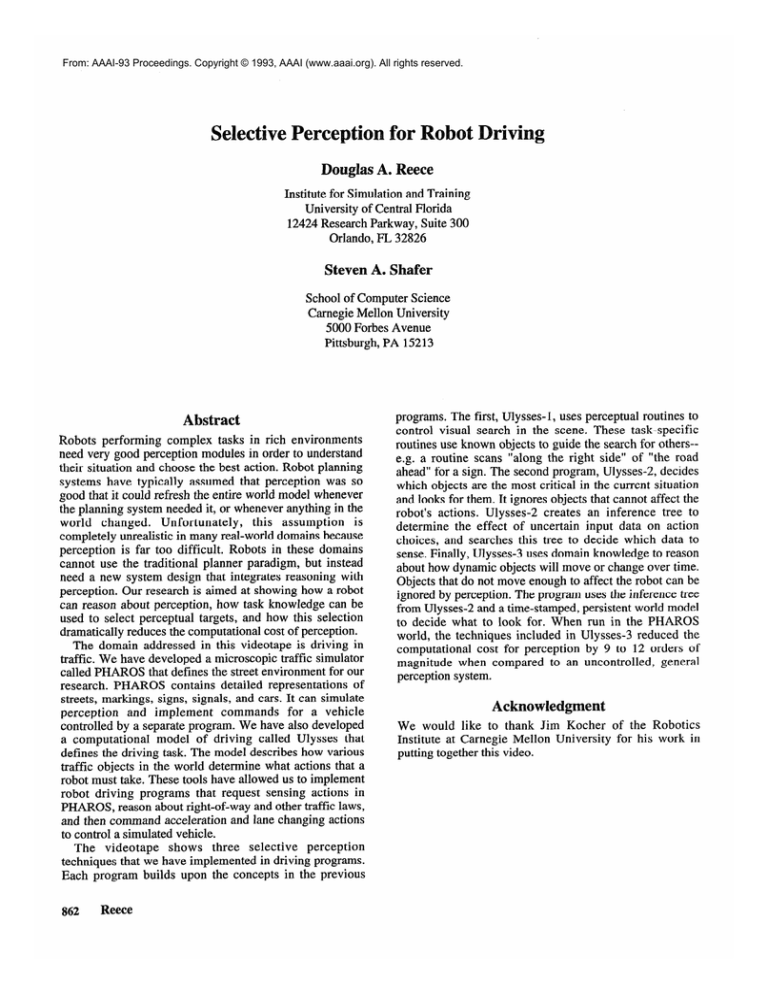
From: AAAI-93 Proceedings. Copyright © 1993, AAAI (www.aaai.org). All rights reserved.
Selective Peree
Douglas A. Reece
Institute for Simulation and Training
University of Central Florida
12424 Research Parkway, Suite 300
Orlando, FL 32826
Steven A. Shafer
School of Computer Science
Carnegie Mellon University
5000 Forbes Avenue
Pittsburgh, PA 152 13
Abstract
Robots performing
complex tasks in rich environments
need very good perception modules in order to understand
their situation and choose the best action. Robot planning
systems have typically assumed that perception was so
good that it could refresh the entire world model whenever
the planning system needed it, or whenever anything in the
world
changed.
Unfortunately,
this assumption
is
completely unrealistic in many real-world domains because
perception is far too difficult. Robots in these domains
cannot use the traditional planner paradigm, but instead
need a new system design that integrates reasoning with
perception. Our research is aimed at showing how a robot
can reason about perception, how task knowledge can be
used to select perceptual targets, and how this selection
dramatically reduces the computational cost of perception.
The domain addressed in this videotape is driving in
traffic. We have developed a microscopic traffic simulator
called PHAROS that defines the street environment for our
research. PHAROS contains detailed representations
of
streets, markings, signs, signals, and cars. It can simulate
perception
and implement
commands
for a vehicle
controlled by a separate program. We have also developed
a computational
model of driving called Ulysses that
defines the driving task. The model describes how various
traffic objects in the world determine what actions that a
robot must take. These tools have allowed us to implement
robot driving programs that request sensing actions in
PHAROS, reason about right-of-way and other traffic laws,
and then command acceleration and lane changing actions
to control a simulated vehicle.
The videotape
shows three selective
perception
techniques that we have implemented in driving programs.
Each program builds upon the concepts in the previous
862
Reece
programs. The first, Ulysses-l, uses perceptual routines to
control visual search in the scene. These task-specific
routines use known objects to guide the search for others-e.g. a routine scans “along the right side” of “the road
ahead” for a sign. The second program, Ulysses-2, decides
which objects are the most critical in the current situation
and looks for them. It ignores objects that cannot affect the
robot’s actions. Ulysses-2
creates an inference
tree to
determine the effect of uncertain input data on action
choices, and searches this tree to decide which data to
sense. Finally, Ulysses-3 uses domain knowledge to reason
about how dynamic objects will move or change over time.
Objects that do not move enough to affect the robot can be
ignored by perception. The program uses the inference tree
from Ulysses-2 and a time-stamped, persistent world model
to decide what to look for. When run in the PHAROS
world, the techniques included in Ulysses-3 reduced the
computational
cost for perception by 9 to 12 orders of
magnitude when compared to an uncontrolled,
general
perception system.
Acknowledgment
We would like to thank Jim Kocher
Institute at Carnegie Mellon University
putting together this video.
of the Robotics
for his work in






